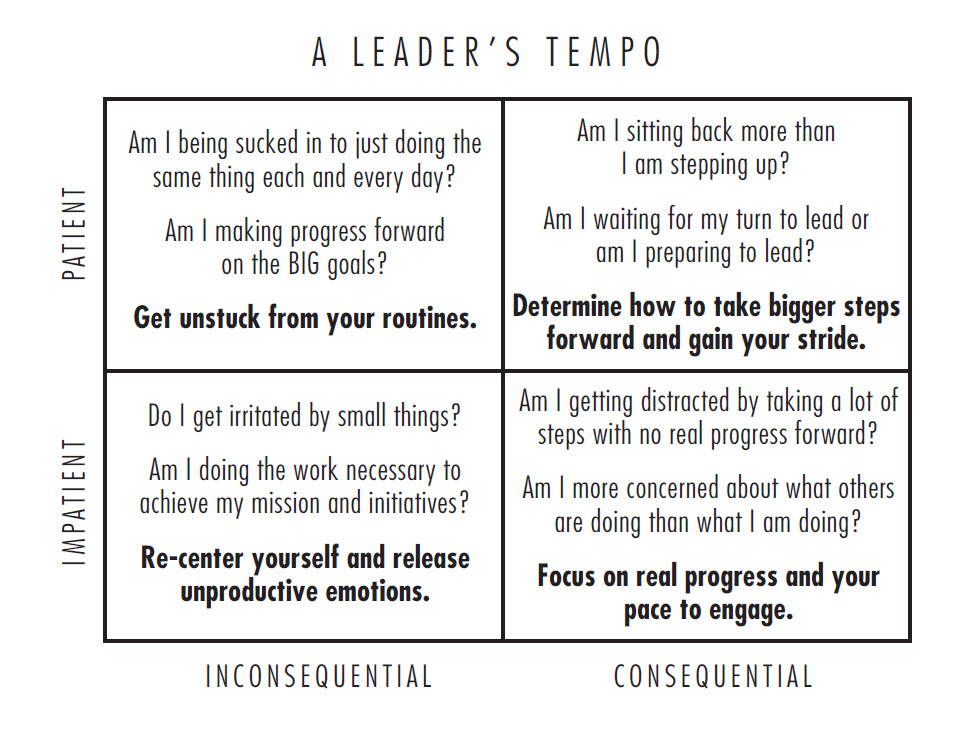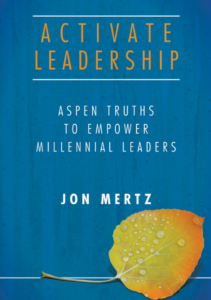Empowering Millennial Leaders
On a trip in the Rockies, Jon Mertz experienced the wonders of aspen trees and walked away with a strong perception that the Millennial generation and these aspen trees shared many of the same qualities. He saw them both as “connection-rich, purpose-filled, and community-centered.”
Jon is the author of Activate Leadership: Aspen Truths to Empower Millennial Leaders and he blogs at Thin Difference. He recently shared some of his concepts and his research into the Millennial generation with me.
Facts About Millennials
You write about Millennials. Share some facts on this generation.
In the United States, Millennials are the largest generation, standing tall at over 80 million, and they make-up over 30 percent of the workplace today. They are quickly becoming the majority. Millennials cannot be ignored and should not be stereotyped. After all, Millennials are the next generation of leaders. Period!
Some statistics that energize me about this next generation of leaders are:
- 64 percent of Millennials say they regularly keep up with what is going on in the world.
- 75 percent of Millennials claim businesses are more focused on personal agendas than helping society, and 6 in 10 want to feel a “sense of purpose” in working for their organization.
- 87 percent believe business success should be measured in terms of more than just financial performance—elements to include are employee satisfaction and retention, customer satisfaction and retention, and contribution to local communities.
What Millennials have the opportunity to create is a new digital citizenship. The new digital citizenship has the potential to enhance trust, transparency, purpose, accountability, and sustainability within and across organizations. I know this sounds lofty, but I believe in what Millennials are bringing to politics, business, and charitable organizations.
Millennial Misconceptions
What’s are the biggest misconceptions about them?
The biggest misperception about Millennials is that they are an entitled generation. New influences were present through societal and technology changes, no different than previous generations. Intensity of change accelerates, though. What I have found is not a sense of entitlement but a sense of how can we make things better. Embedded in this is a strong sense of purpose and problem solving. These are the traits Millennials are using.
An example of this is the Food Recovery Network. Two college students volunteered at a nearby homeless shelter. Back on campus after lunch, they saw good food being thrown away. How can people a few miles away have little food and good food is being thrown away here? They set out to solve this problem by working with the university to deliver the food to nearby shelters. Today, this social good initiative is active in over 160 chapters and has recovered over 1 million pounds of food across the United States.
Millennials are not entitled, but they are blazing a trail of renewal in solving real problems with purpose-filled solutions.
Find the Right Tempo
Let’s talk about patience. You say it cultivates growth. There are other times that we need a high sense of urgency and drive. How do you know what is needed?
There is no stock answer to finding the right tempo between patience and impatience. What patience engages is a visual of pace and stride. Patience embodies doing the work, learning our craft and honing our skills. Being patient is not wasted time. It is as Steve Martin said, “Being so good they cannot ignore you.”

On the order side is stride. To achieve bigger missions and purpose, we need to step up to start a company, change jobs, move on, or re-start. Getting this timing right takes the right alignment of heart and mind. More specifically:
- Take the stride if your heart and mind are telling you the same thing. Solid alignment is present.
- Avoid taking the stride if your heart and mind are not aligned. Lean into the uncertainty and write down what is stirring up the uncertainty. Patiently do the work to eliminate the uncertainty.
- Keep the pace if your heart is at ease and your mind is uncertain. More may need to be learned. More may need to be understood.
- Disrupt your pace if your heart is restless and you are not learning anything new. The time may be ripe to explore what your real purpose is and where your talents can best be applied.
Anyone that gives you a stock answer on making this choice is being disingenuous. Finding the right connection between heart and mind takes effort by the individual. Others can help in the discernment, and they should be called upon. Ultimately, finding the right tempo is up to the individual and the people interdependent with them.
Ensure Effective Collaboration
What are some of the ways to ensure effective collaboration?
Clarity is the fuel to make collaboration work well. Clarity delivers the vision, roles, responsibilities, and accountability. Get clarity right first.
Transparency is a partner to clarity. Hidden agendas need to be exposed and eliminated. Self-interest needs to be identified and held accountable. Knowing what each individual is responsible for and supporting them in ways that benefit the higher goal is essential. Transparency builds trust, and trust ensures transparency.
Finally, collaboration requires space. More than just physical space, collaboration needs think, heart, and technology space. We need individual think time to develop ideas and prepare for effective collaboration. We need heart space to develop and express our passion. We need technology space to empower our work rather than frustrate it. All these space factors need to come into full play in order to facilitate effective collaboration.
Clarity, transparency, and space enliven the right collaborative results.
Millennials are driven by a strong sense of purpose, both personally and professionally. Knowing this, what should leaders who employ many from this generation do to tap into this desire?
The first key action for leaders is to define work and initiatives with extreme clarity of purpose. Every role in a company serves a purpose in terms of exceeding customer satisfaction, being profitable, generating revenue, and building an engaging stakeholder community. Leaders need to define work in terms of the purpose it serves.
The same is true for initiatives. Three questions, at a minimum, need to be answered with clarity:
- Why do we need to pursue this initiative?
- What will the other side of completion look like? In other words, what is the new desired state?
- Why can’t we stay at status quo?
Millennials are inspired by clarity of purpose, as are other generations.
The final element is to communicate what the overall purpose of the business is and enhance it as new trends come alive, or industry shifts happen. Involve Millennials in helping preserve the company purpose while advancing it as the marketplace and customer needs change.
There is an enduring element in purpose yet it also needs to be cared for and grown in strength and intensity. Millennials are the next generation of leaders, so embrace them to help tend to the purpose of the business and culture.
Share with us the concept of “convert to thrive.”
Today, there is an abundance of information and choices. We need to sort and absorb what is most important without sacrificing depth to our understanding and knowledge. However, we must do more than just absorb. We need to take the vital step of converting what we learn into tangible, results-oriented growth.
Aspens are designed to absorb more sunlight than other trees. Through their fluttering leaves and gray, thin bark, aspens are built to absorb sunlight and then convert it for growth.
Similarly, Millennials are designed to absorb a lot of information. They know how to find information and take it all in through diverse channels. Now, to sustain their leadership growth, results are necessary, so defining outcomes and steps to move forward in a defined direction is a difference-maker in their leadership skills, capabilities, and ability to stand out.
Working Across Generations
What tips do you have for Millennials about communicating and working in organizations led by Generation Xers or Baby Boomers? How do they minimize frustration and maximize their chances for promotion?
 Empathy is vital. Empathy is not a fluffy concept; there is great leadership strength in using empathy to activate others. Empathy is simply putting yourself in another’s viewpoint and experience and listen to understand and gain insight. Through empathy, relationships are built, and this is where Millennials can extend an open mind and ear, asking probing questions of other generations.
Empathy is vital. Empathy is not a fluffy concept; there is great leadership strength in using empathy to activate others. Empathy is simply putting yourself in another’s viewpoint and experience and listen to understand and gain insight. Through empathy, relationships are built, and this is where Millennials can extend an open mind and ear, asking probing questions of other generations.
The challenge for older generations is to use empathy as well. My fear is that there has been a lot of stereotyping of Millennials, and minds are now becoming closed. Older generations need to be open to listen to Millennials as well. When generations come together in openness of perspectives and experiences, leadership grows exponentially for everyone involved.
For Millennials to minimize frustration, it is important to remember pace. Keep listening, doing the work, and learning from various generations, and good things will happen. If a mutual openness takes hold, more stride moments will open sooner rather than later.
Activate Leadership: Aspen Truths to Empower Millennial Leaders

